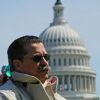Sept. 16 has become yet another horrendous day that will long be remembered in the nation’s capital. As folks were starting to report to work at the Washington Navy Yard 1, one of the most unthinkable events quickly and unexpectedly unfolded. On a gray, cloud-covered and damp Monday morning, automatic weapon fire shots rang out.
Apparently a disgruntled former Navy Petty Officer — Arron Alexis of Fort Worth, Texas — opened fire inside of Building 197. This is the Naval Sea Systems Command facility office building. At the time of this report, the motive has not been determined.
The current count has the shooter killing 12 and injuring another 12 — two of the injured are police officers. The shooter died in a gunfight with police.
Both police officers (one of the injured worked as front gate security for the Navy Base and the other one was a D.C. officer returning fire at the shooter) are listed in critical, but stable condition at this time.
Please keep in mind that this incident is only hours old, so the “fog of war” rule applies — expect this information to be improved and revised as time passes.
Emergency response
At about 8:15 a.m. today, Washington Navy District Fire Department Engine 41 and Ambulance 41 was dispatched to Building 197 for a shooting. Very early into the event the fire officer called for a response from the District of Columbia Fire Department.
The scope of this shooting was declared a mass-casualty incident, which activated a large emergency medical response. At the same time, the regional hospital trauma facilities were ramped up to receive and treat a larger number of gunshot-wound patients.
Before this event could be brought under control, a National Capital Region fire-rescue response would be required, bringing resources from both nearby Maryland and Virginia. Without question, all of the first responders, police and fire along with all of the hospital medical staffs, distinguished themselves as community heroes by how they handled this event.
Train like it matters
The Navy yard incident underlines and highlights the need for all fire-rescue departments to be alert and prepared to respond to similar events. First, having updated, clear policies that address active shooters and how to manage MCI events are critical. As a reminder, if there are policies of any type there must be initial and on-going training to make sure that all operational members understands the plan and what their role is within the plan.
Next, be alert and aware of all conditions at all events — there are no routine alarms of any types. Once it is determined that there is an active-shooting event under way, there is very little protection that fire-rescue units are offered or can apply.
The Department of Homeland Security offers that the best practice to apply if caught in an active shooter event is “run, hide, fight.” The first suggested action is to get away from the shooter and stay out of the path of the potentially fatal threat.
If running is not an option, protect yourself in place by hiding from the active shooter. Finally, as a last resort, be prepared to fight the shooter if the first two options are not at your disposal.
Watch the video
Sometimes it is impossible for fire-rescue personnel to implement any of the above steps, so we have to rely on the police agencies to protect us as we play a major and mission critical role within the hazard zone.
The Department of Homeland Security commissioned a video clip called “Surviving an Active Shooter Event.” This great training tape was developed by Houston under a federal grant in a program that is called Ready Houston.
I suggest that all members of every fire-rescue department invest the six minutes to view this video and have a follow-up discussion about the three steps. There are many active-shooter training courses and drills held all across our nation — attend one and participate in a hands-on drill.
Please remember to coordinate and communicate with our public safety first-response partners and law enforcement. Having a coordinated and unified response will never be more important than at an active-shooter event.
Of course the police will be the lead agency to deal with neutralizing the threat to life, while we will be the lead for providing emergency medical care. This coordination must include policy, planning, training, plan exercising and actual event implementation must occur long before the 911 caller reports shots ringing out.












